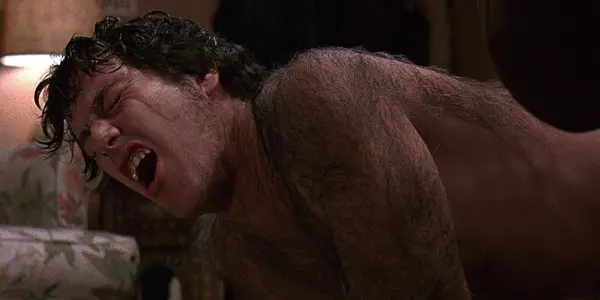The first Oscar ever given for makeup was for Tony Randall dressed as an abominable snowman. And a snake. And a satyr. And a wildly offensive Chinese stereotype. The year was 1964, the film 7 Faces of Dr. Lao. The film is formally poor and virulently racist. But the movie won an Oscar, for makeup artist William J. Tuttle’s tremendous skill at transforming Randall into these creatures and the titular Dr. Lao, as well as Medusa, Merlin, and an ancient Greek philosopher.
The 1964 Academy Awards was the first show to recognize makeup design with a special achievement trophy, and it would take the Academy 18 years to make it a formal competitive category. In 1993, hairstyling was added to the category. The makeup and hairstyling Oscar is refreshingly simple, concerned first and foremost with how well artists can transform actors physically to suit their roles. Regardless of a film’s quality, message, or politics, be it 7 Faces of Dr. Lao or Suicide Squad, the makeup branch is solely focused on the quality of the craftsmanship and the audaciousness and accuracy of the transformations.
An American Werewolf in London And The Category’s History
The Academy awarded two special achievement makeup Oscars before 1982 — one for 7 Faces of Dr. Lao in 1964, and another four years later, for John Chambers’ groundbreaking prosthetic work for Planet of the Apes. But besides these films, plenty of deserving makeup work was snubbed. 2001: A Space Odyssey, Star Wars, Star Trek: The Motion Picture, Alien, Time Bandits, and Raiders of the Lost Ark all came and went without makeup recognition at the Academy Awards.
Many ascribe the category’s introduction to the incredible makeup and prosthetic work in An American Werewolf in London, particularly the gruesome transformation scene. But that’s a common misconception. It’s the makeup snub for David Lynch’s The Elephant Man, for which Christopher Tucker took eight hours a day to turn John Hurt into the titular character, that prompted the Academy to christen a new category.

Rick Baker’s incredible werewolf and gore effects on An American Werewolf in London scored the film the first-ever makeup Oscar in 1982 when Heartbeeps was its only competition. Baker went on to earn 10 more nominations and 6 more wins, for Harry and the Hendersons, Ed Wood, The Nutty Professor, Men in Black, How the Grinch Stole Christmas, and, bringing his career full-circle, 2010’s The Wolfman.
Between 1982 and 2018, the category had two to three nominees each year. Starting in 2019, the field was expanded to the normal five categories.
Transformations, Fantasies, And Period Pieces
7 Faces of Dr. Lao (and later, The Elephant Man) launched the category’s long history of recognizing famous actors undergoing severe cosmetic makeovers. The Fly, Beetlejuice, Bram Stoker’s Dracula, and many other films continued this tradition of taking A-listers and making them unrecognizable. That’s a recent trend as well; Darkest Hour, Vice, and Bombshell relied on the visionary makeup effects of such luminaries as Kazuhiro Tsuji to transform Gary Oldman, Christian Bale, and John Lithgow into heavyset characters. (Tsuji’s first Oscar nomination in the category was for Adam Sandler’s similar transformation in Click.)
Equally reliable is the dominance of sci-fi and fantasy films in the category. For winners like Quest for Fire, Dick Tracy, Lord of the Rings: The Fellowship of the Ring, and Mad Max: Fury Road, nearly every character has a unique makeup or prosthetic design. There’s no singular character design being awarded, as in Darkest Hour or Bombshell.
For years when neither the fantasy nor sci-fi genres seem particularly deserving or when there’s no high-profile actor transformation, the makeup branch likes to honor period-accurate or expressionistic work in historical dramas, like Braveheart and Les Misérables. For the 2021 Oscars, all these trends are on display with the nominees: Ma Rainey’s Black Bottom and Hillbilly Elegy (actor transformations), Pinocchio (fantasy films), and Emma. and Mank (period pieces).
Conclusion: The Legacy Of The Makeup Oscar
The enduring legacy of the makeup and hairstyling award is one of inclusion. The makeup branch of the Academy of Motion Picture Arts and Sciences is often accommodating and genre-friendly where the rest of the Academy can be snooty and conceited. Historically, the Best Picture frontrunners and the Oscar bait films do not win Best Makeup and Hairstyling. This category started with 7 Faces of Dr. Lao for goodness’ sake, and that film has a scene where a boy fires up a rain machine to stop a Loch Ness Monster from eating a circus ringmaster.
The category has always been about craft first and foremost, usually devoid of the politics, career recognition, and awards-jockeying that can mar the rest of the show. This is the only category where Schindler’s List and Philadelphia could be nominated and lose to Mrs. Doubtfire.
The makeup branch awards a completely different caliber of film than the rest of the Academy. Some critically reviled movies have earned makeup nods (Heartbeeps, Bicentennial Man, Norbit), and some have even won (Suicide Squad). The category manages to award a wide variety of deserving films that would otherwise get no awards play, based purely on the strength of their makeup and prosthetic achievements. Every year, you can rely on the makeup branch to deliver at least one bonkers nomination. That’s what makes the makeup and hairstyling category so special — it’s about game recognizing game. Even when that game is 7 Faces of Dr. Lao.
What are your favorite wins for Best Makeup and Hairstyling? Comment below with your thoughts.
Does content like this matter to you?
Become a Member and support film journalism. Unlock access to all of Film Inquiry`s great articles. Join a community of like-minded readers who are passionate about cinema - get access to our private members Network, give back to independent filmmakers, and more.